![]()
![]()
![]()
Use LEFT and RIGHT arrow keys to navigate between flashcards;
Use UP and DOWN arrow keys to flip the card;
H to show hint;
A reads text to speech;
98 Cards in this Set
- Front
- Back
- 3rd side (hint)
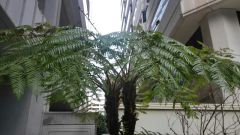
Dicksonia antarctica
|
Tasmanian tree fern- Dicksoniaceae Stems remain on trunk for some time after the fronds fall, so trunk has 'broken stems' Susceptible to frost; thrives closer to coast/bay where temperature is more temperate deer resistant; slow growing Evergreen; shallow, fibrous root system Usually has a single trunk Skin irritant Most widely used tree fern |
|
|
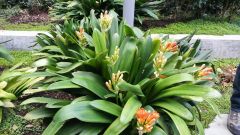
Clivia miniata |
NCN - Magnoliaceae Amaryllis family - bulb Variegated foliage (flowers can be deep red, orange, yellow); orange/red fruit Basal leaf shape Evergreen; prefers shade (needs protection from afternoon sun); slow growing Stem that flower is on is bare (naked scate?) |
|
|
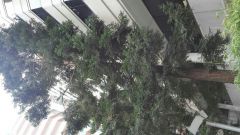
Sequoia sempervirens |
Coastal redwood - Cupressaceae Scaled conifer family Each 'needle' is considered a leaf Clusters of bud scales show each new year's growth Needles lay flat to mazimize sunlight capture Tree gets most of its water from fog (85%) In some species, juvenile foliage on top looks very different from mature foliage |
|
|
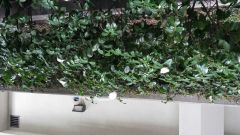
Camelia japonica - Theaceae (tea family) |
Has 5 petals surrounded by a petalloid structure (modified stamens that resemble petals, making the flower look much fuller)Evergreen; disease resistant; temperate climate plant80% of the roots are in the 1st 2 feet (lower than that there is less oxygen)Juvenile plants require a lot of water |
|
|
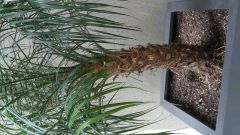
Phoenix roebelenii |
Pygmy date palm - Arecaceae Palmae Pinnate (feathered leaf structure) Armed (thorns at base of stem are typical of date palms) |
|
|
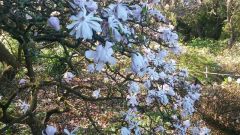
Magnolia stellata 'Waterliliy' |
Star magnolia - Magnoliaceae Bright white to pink flowers Asian magnolia 12-18 Tepals (sepals and petals look the same) Smaller magnolia good for smaller spaces Floral column in center resembles a pine cone Has brachts (furry tough 'leaf' that the flower buds emerge from) |
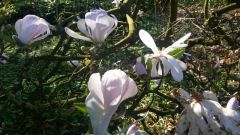
|
|
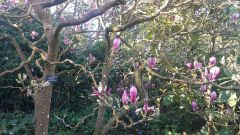
Magnolia x soulangeana 'Picture' |
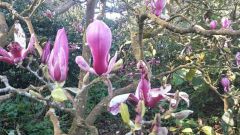
Saucer magnolia Hybrid between to different parent magnolias Large color range Blooms on bare trunks ( with no leaves) Lichen (can be gray orwhite) and moss grows on trunk Leaves are alternate Can tolerate direct sun and dappled woodland light in Bay area Only blooms once a year |
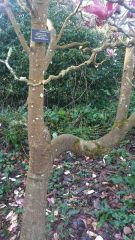
|
|
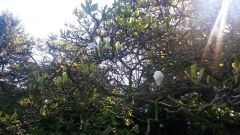
Magnolia denadata |
? |
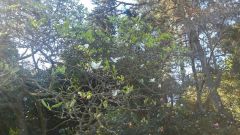
|
|
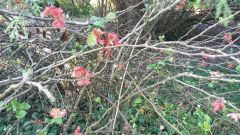
Chaenomeles cultivar |
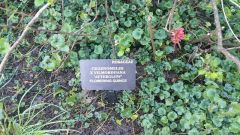
Flowering Quince - Rosaceae Used in ground and in containers Rose family- has thorns, flowers early inseason, without pruning they tend to grow upright. If you favor a horizontal branch, you get more clusters of flowers Likes full sun; slow growing; alternate leaves Color range (white, pink, red, yellow-orange) Deciduous; if it lays on the ground it will root |
|
|
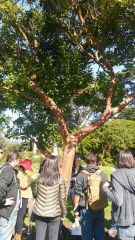
Arbutus x 'Marina' |
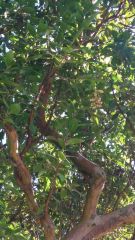
NCN - Ericaeae (acid loving) Woody member of the Heather family (has lantern shaped flowers) Strawberry sized fruits Messy fruit (don't plant near walking areas) Dont plant near cement (foundations, paving which are alkaline) because they need acidic soil Need perfect drainage (sandy soil) Medium to small tree Characterized by peeling bark as new bark is produced underneath Elliptic serrate leaves; alternate; evergreen Lichen growns on north side of trunk |

|
|
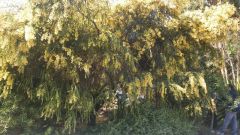
Acacia pravissima |
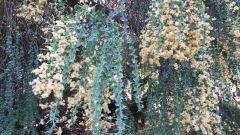
Owens wattle - Fabaceae White yellow or orange flowers Very drought tolerant 'Lacy' small leaves are petioles Petioles turn silver later in the season Evergreen |
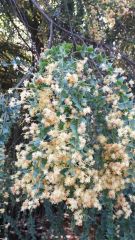
|
|
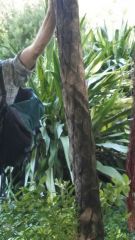
Sphaeropteris cooperi |
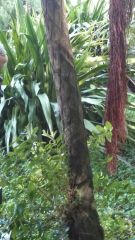
Australian tree fern - Cyatheaceae Narrower, taller and more graceful than Dicksonia Large oval scars from fronds that have fallen Skin irritant (spores) |
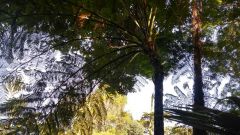
|
|
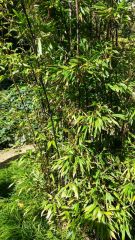
Phyllostachys nigra |
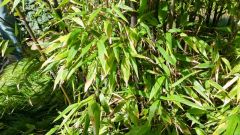
Black bamboo - Poaceae Grows once then dies Commonly used in Bay Area Invasive so it has to be put surrounded with a root barrier (2 feet deep) to prevent it from running (spreading); horizontal barrier should to visible to maintain boundaries Alternately arranged There are many cultivars of black bamboo New shoots start out green then turn black Length of segments gets much shorter at bottom of the stem Silkus alternates sides on each length of stalk |
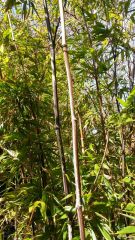
|
|
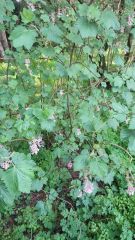
Ribes sanguineum var glutinosum |
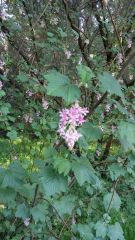
Pink flowering currant - Grossulariaceae Foliage is sticky (glutinousum) Semi-deciduous Full sun to deep shade Fragrant Deer resistant |
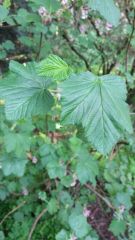
|
|

Cornus sericea |
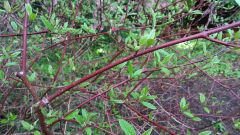
Redtwig dogwood - Cornaceae Sends out many horizontal roots; therefore useful in stabilizing soil Red twigs (like white willow) Small white flowers (not showy) Opposite leaf arrangement Deciduous (not herbaceous)
|

|
|
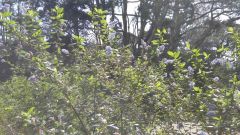
Ceanothus spp. & cvs |
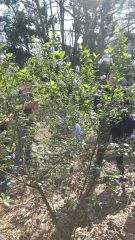
California lilac - Rhamnaceae Evergreen Tree-like form Three major veins in each leaf (useful in ID when there are no flowers Don't need much water Deer love these Requires excellent drainage |
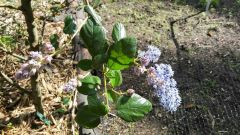
|
|
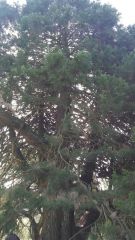
Sequioadendron giganteum |
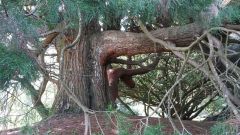
Sierra big tree - Cupressaceae (scaled conifers) More narrower and more prickly than the coastal redwood Most massive tree in the world Always grows in mixed groves of trees Grow well at sea level but don't live as long Needs good drainage Lichen and moss grow on the trunk |
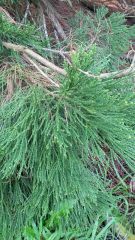
|
|
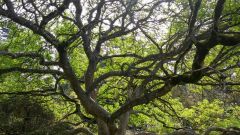
Aesculus californica |
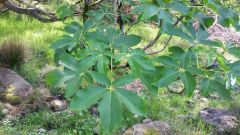
California Buckeye - Sapindaceae Deciduous Oppositely arranged Compound palmate leaf (compound leaves spring from petioles not from the base of the stem Poisonous foliage; fragrant Lichen and moss grow on trunk Typically 5 leaflets Gets large Multi-trunk; sculptural |
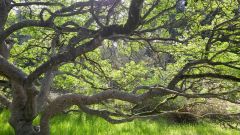
|
|
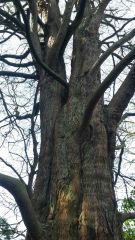
Metasequoia glyptostroboides |

Dawn redwood - Cupressaceae Fast growing Knarly, muscled trunk Deciduous Opposite foliage (this is the only redwood type tree with opposite arrangment) Prefer wet locations (i.e. near rivers) Won't die if river floods and leaves several feet of silt |
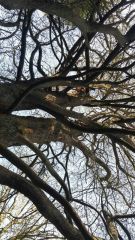
|
|
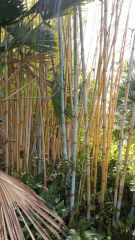
Himalayacalamus hookerianus |
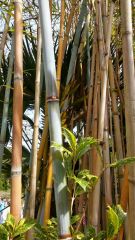
Blue bamboo - Poaceae Will never be blue in bright sun As they mature the stems change from 'blue' to warm yellow Has a larger diameter than black bamboo No shortening of the segments like black bamboo |
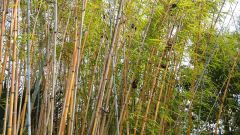
|
|

Artemisia californica |
California sagebrush - Asteraceae (aster, daisy, composite or sunflower family) Drought and deer tolerant shrub Evergreen; native Requires good drainage and full sun Inconspicuous white flowers Thrives in coastal environments |
|
|
|
Baccharis pilularis |
Coyote bush - Asteraceae |
|
|
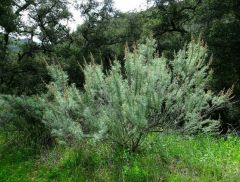
Artemisia californica |

California sagebrush - Asteraceae Evergreen shrub; native to coastal region from Northern California to Baja California; Drought tolerant; finely divided grayish white foliage |
|
|

Baccharis pilularis |
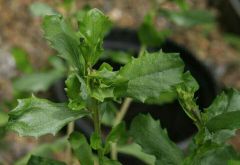
Dwarf coyote brush - Asteraceae Native to Northern California coast; Near the coast it thrives with no water; 8-24 inches high; evergreen shrub; withstand heat, wind and poor soil |
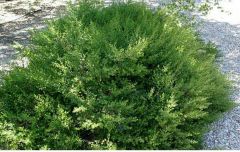
|
|
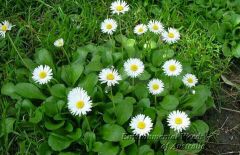
Bellis perennis |

English daisy - Asteraceae Perennial; pink, rose, red, white flowers |
|
|
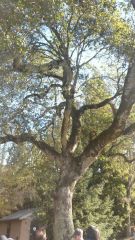
Quercus agrifolia |
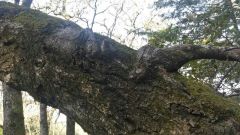
Coastal live oak - Fagaceae Evergreen; lichen and moss grow on it; closer to the coast it is more stunted and has more lichen and moss; cannot introduce lawn adjacent to an established tree; often suffers from sudden oak death; has male and female flowers; cup shaped leaves (revolute) with tufts of hair in axle of veination; agri means prickly (leaves are prickly) |
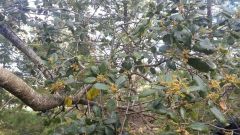
|
|
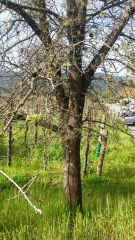
Quercus lobata |
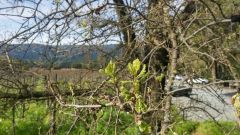
|
|
|
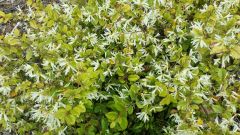
Loropetalum chinense |
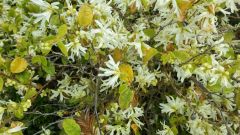
Fringe flower - Hamamelidaceae (witch hazel family) Loro (means strap) flowers have straps Evergreen, alternate leaves Grows up to 12 feet tall |
|
|
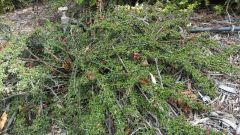
Cotoneaster spp. & cvs |
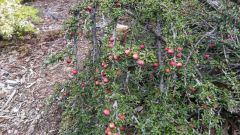
NCN- Rosaceae ( rose family) Evergreen, pinkish white flowers, small fruits that look like apples; deer resistant; can be used as groundcover |
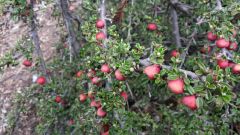
|
|
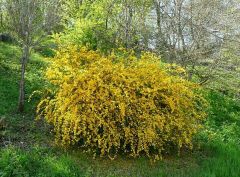
Kerria japonica |
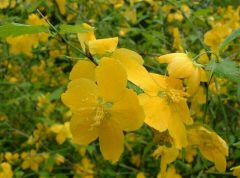
Japanese rose - Rosaceae 5 petal yellow flowers; green stems; stems are bare when flowers bloom |
|
|
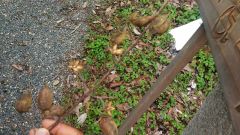
Pawlownia spp |
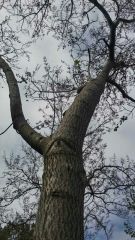
Princess tree - Pawlonia Divided seed pods that look like castinets; purplish- blue flowers; opposite leaves; round leaves |
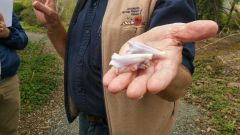
|
|
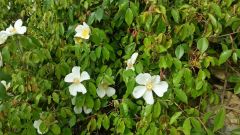
Rosa spp & cvs |

Rose - Rosaceae Only five petals but pettaloids often make them look much fuller. |
|
|
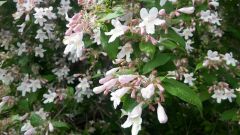
Kolkwitzia amabilis |

Beauty bush - Caprifoliaceae Opposite leaves; |
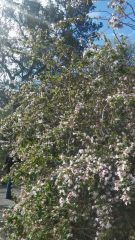
|
|

Cercidiphyllum japonicum |

Karsura tree- Cercidiphyllaceae Serrate opposite leaves Resembles redbud; flowers nor showy; yellow-bronze fall color |
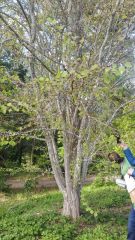
|
|
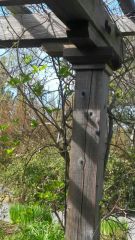
Wisteria spp & cvs |
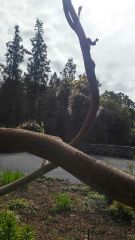
NCN - Fabaceae Full sun; deciduous Pinnate leaves; japanese species has more leaflets than chinese species; japanese has a longer cluster of flowers (up to 2 feet); attracts bees; blooms on old growth |
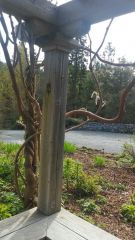
|
|
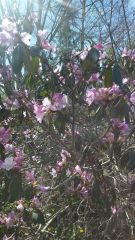
Rhododendron spp & cvs |

Rhododendrons and Azaleas - Ericaceae Some are evergreen, other deciduous; |
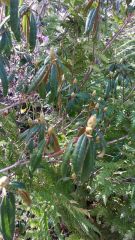
|
|
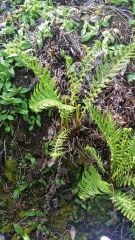
Athyrium filix-femina |
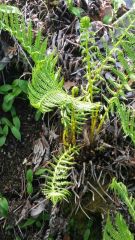
Lady fern - Arthyriaceae Bi-Pinnate; narrow waist; native to Bay Area; herbaceous; leaves feel lighter or more delicate than some of the other species.
|
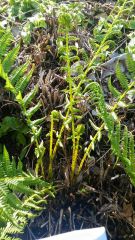
|
|
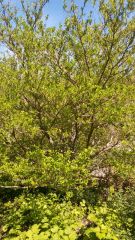
Styrax japonicus |
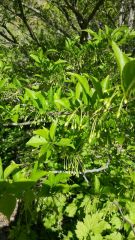
Japanese snow bell tree - Styracaceae Oval shaped leaves; tear shaped white flowers; fruit resembles a dangling earring |
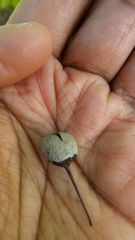
|
|

Enkianthus camanulatus |
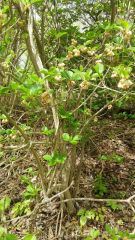
NCN -Ericaceae Morning sun exposure |
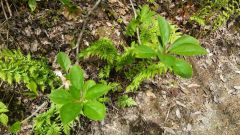
|
|
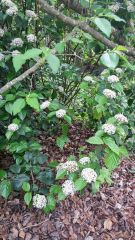
Viburnum spp & cvs
|
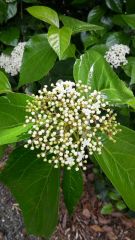
NCN - Caprifoliaceae 5 petals (hydrangeas are multiples of 2); opposite arrangement |

|
|
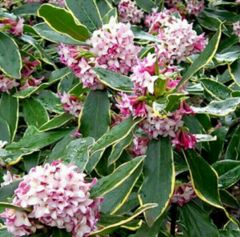
Daphne odora 'Marginata' |
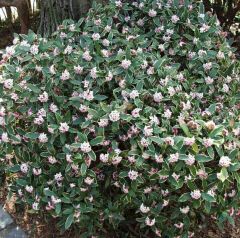
Variegated winter daphne - Thymelaeceae Evergreen; fragrant; Narrow, thick, glossy yellow-edged leaves; |
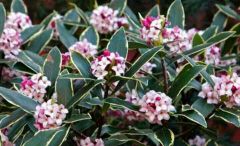
|
|
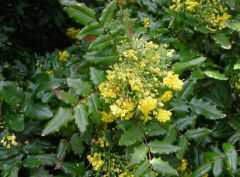
Berberis aquafolium |

Oregon grape - Berberidaceae Compound leaf; evergreen Yellow flowers; blue berries New growth has bronze-red color and turns deep glossy green; Foliage turns purplish-red when weather cools down; part to full sun |
|
|

Quercus lobata |
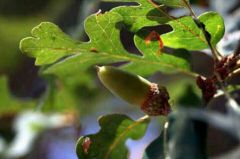
Valley oak - Fagaceae Deciduous Ash grey checkered bark; Up to 70' with spreading canopy and sculptural limbs; galls the size of golf balls form for wasp larvae |
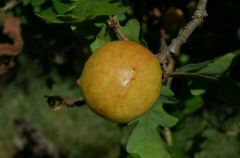
|
|
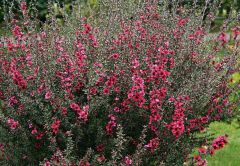
Leptospermum scoparium & cvs |
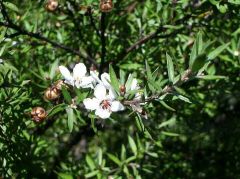
New Zealand tea tree (Manuka) - Myrtaceae Evergreen; sweeping branches Small pink, red or white flowers; full sun |
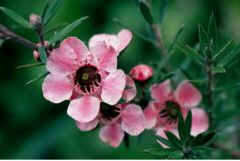
|
|

Magnolia liliiflora |

Lily flowered magnolia - Magnoliaceae Deciduous shrub with upright open branch; two-tone flowers with purple-red exterior/ pink interior Full sun |
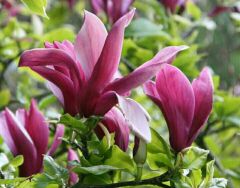
|
|

Eschscholzia californica |
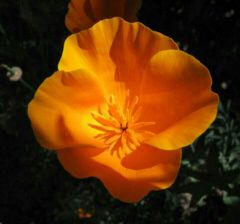
California poppy - papaveraceae Perennial; pale yellow to deep orange flowers; 8-24 in stems and blue/ green finely divided leaves; flowers close at night and on overcast days |
|
|
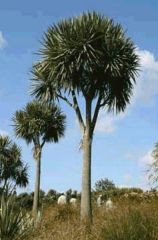
Cordyline australis |
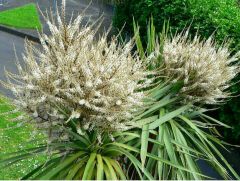
Cabbage palm - Asparagaceae Widely branched monocot; Stout trunk; sword-like leaves; tall, straight trunk and dense round heads; evergreen shrubs or tree-like perennials |
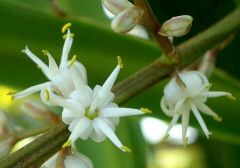
|
|
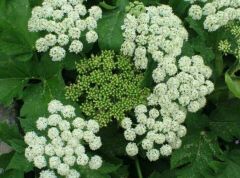
Heracleum lanatum |
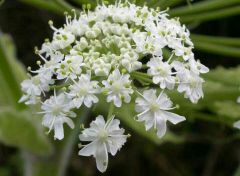
Indian parsnip - Apiaceae (carrot family) Perennial; (lanatum) covered with wooly long hair; Stems often hollow between nodes; stands up to 9 feet; rosette of large lobed leaves followed by stout flower stems carrying large umbels of white flowers |
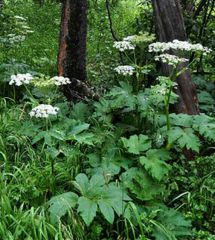
|
|
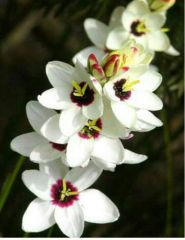
Ixia specimens |

Corn lily - Iridaceae Perennial; clump of narrow, grass-like leaves sends up wiry, 18-20 inch stems topped by short spikes of 2" flowers with 6 petals; colors range from cream, yellow, red, orange and pink, usually with dark centers |
|
|
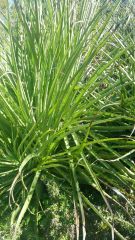
Puya chilensis |

Hummingbird's perch - Bromeliaceae Inflorencense rises several feet. Native to Chile. Drought tolerant |
|
|
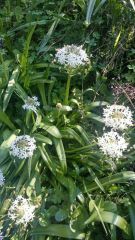
Scilla & Hyacinthoides |
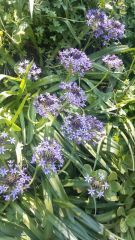
Squills and bluebells - Asparagaceae This is a Peruvian squill. Only evergreen if it has sufficient water. |
|
|
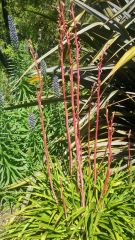
Beschorneria rigida |
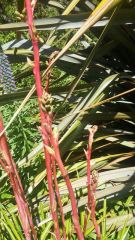
Spring agave - Asparagaceae Evergreen; asparagus family From Mexico |
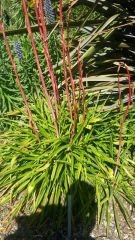
|
|
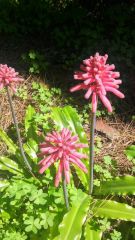
Velthemia bracteata |

Sand lily - Asparagaceae Looks like birdsnest fern; Glossy, undulating leaves; |
|
|
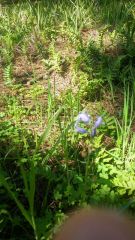
Hyacinthoides |
English bluebell |
|
|
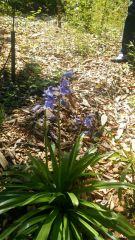
Hyacinthoides |
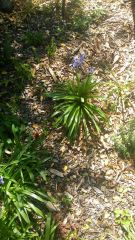
Spanish bluebell - Asparagaceae |
|
|
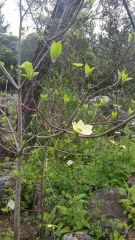
Cornus nutallii |

Mountain dogwood - Cornaceae Needs excellent drainage Scarlet red fall color; 15-20 feet high; Photos show young specimen |
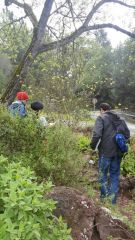
|
|
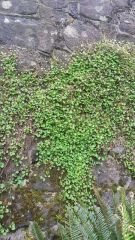
Cymbalaria muralis - not native |
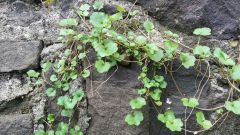
Kenilworth ivy - Plantaginaceae Can also be ground cover; lack of water and full sun will limit it's proliferation |
|
|
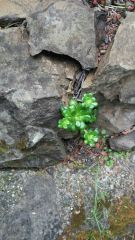
Sedum spathulifolium |
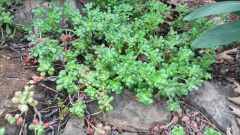
Broadleaf stonecrop - Crassulaceae Succulent ground cover; has 4" tall clusters of yellow flowers; will grow on vertical rock faces |
|
|
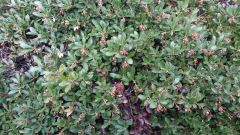
Arctostaphlos uva - ursi |

Bearberry - Ericaceae Fruit resembles small red apples; attracts bears; edible; hanging bell shaped flowers typical of this family; evergreen; deer and drought tolerant |
|
|
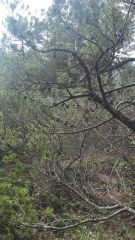
Pinus contorta |
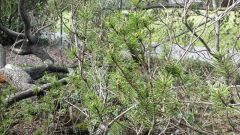
Shore pine - Pinaceae The wind causes it to contort 2 needles in a bundle Open, softer cones |
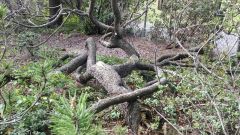
|
|
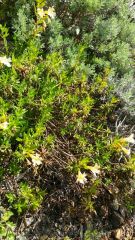
|
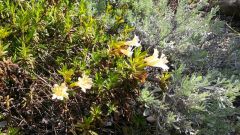
Sticky monkey flower |
|
|
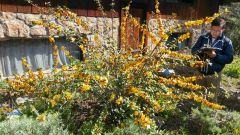
Fremontodendron californicum |
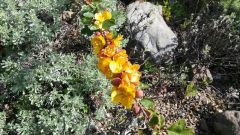
Flannel bush - Malvaceae Drought tolerant; skin irritant Full sun; summer deciduous (drops leaves if there is a lack of water. |
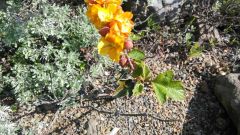
|
|
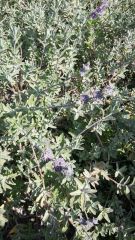
Salvia leucophylla |
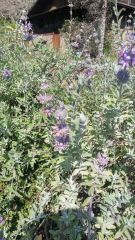
Purple sage - Lamiaceae Lanculate leaf shape; puckered tapering leaves; lighter than black sage |
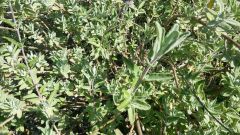
|
|
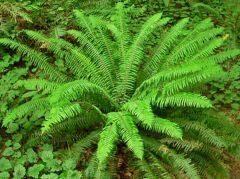
Polystichum munitum |
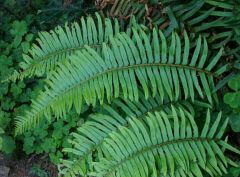
Western sword fern - Dryopteridaceae Has sword 'hilt' at base of leaf Evergreen fern; every year new growth will replace the old Small thorn on leaf edge; good woodland plant (does not like afternoon sun) |
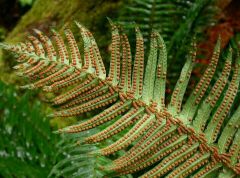
|
|
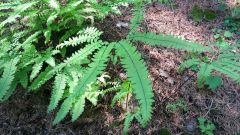
Adiantum aleuticum Adiantum (not wetting); water beads on the surface |
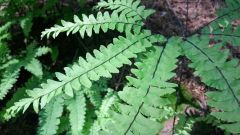
Maidenhair fern - Pteridaceae Black stem ; wing shaped leaves Light shade; leaves repel water |
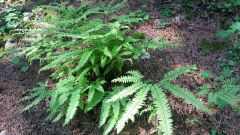
|
|
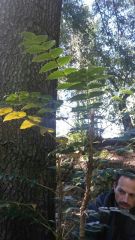
Berberis nervosa |
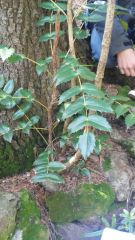
Long leaf barberry -Berberidaceae Triple nerved opposite leaflets (pronounced veins) no bud at base of leaflet |
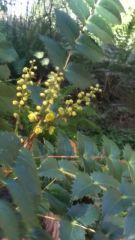
|
|

Quercus chrysolepis (golden hairs on acorn cap) |
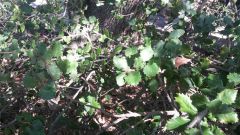
Canyon live oak - Fagaceae Evergreen; chevron regular veination; slightly bluish underside of leaf (quercus agrifolia has green underside) ; lower leaves are more prickly to prevent "browsing" |
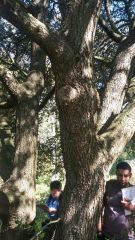
|
|
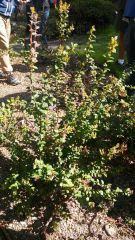
Vaccinium ovatum |
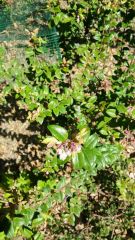
Evergreen huckleberry - Ericaceae Ovate (egg shaped) leaf; attracts bears; blue-black berries |
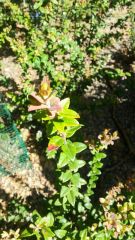
|
|
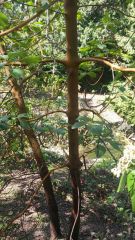
Arbutus menziesii |
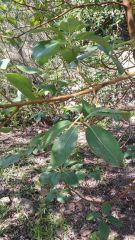
Madrone - Ericaceae Orange-red berries and white flowers; prone to fungal leaf spot. Alternate leaf; evergreen |
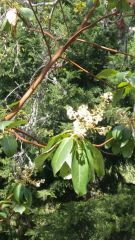
|
|

Dryopteris arguta |

Coastal wood fern - dryopteridaceae Drought tolerant; evergreen; light green foliage; donut shaped spores |
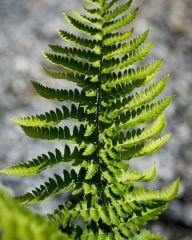
|
|
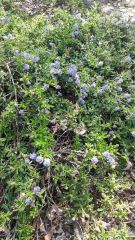
Ceanothus hearstiorum |

San Simeon Ceanothus - Rhamnaceae Small leaves; prostrate; needs to be protected from deer; full sun |
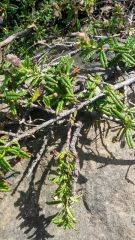
|
|
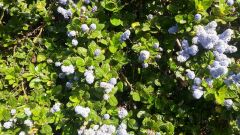
Ceanothus griseus horizontalis |

'Yankee point' - Rhamnaceae Attracts pollinators like other types of ceanothus |
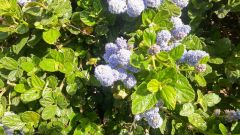
|
|
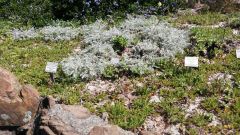
Artemisia pycnocephala |

Coastal sagewort - Asteraceae Ever"grey" |
|
|
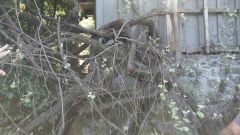
Vitis spp & cvs |
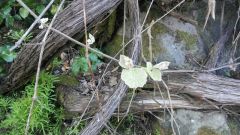
Grape - Vitaceae Lobed serrated alternately arranged leaves; exfoliating bark; flowers are white and sometimes tinged with pink. |
|
|
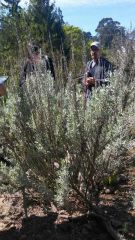
Artemisia tridentata |
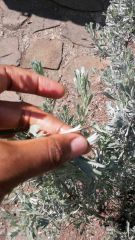
Great basin sage - Asteraceae |

|
|

Jubaea chilensis |
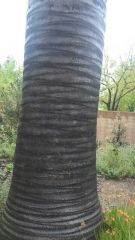
Wine palm - Arecaceae |
|
|
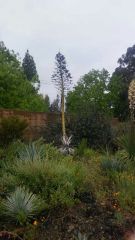
Hesperoyucca whipplei |
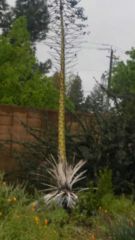
Spanish bayonet - Asparagaceae |
|
|

Nolina recurvata |
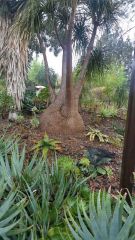
Ponytail palm - Asparagaceae |

|
|

|

Puya |
|
|
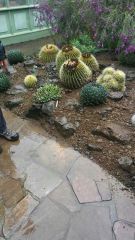
Echinocactus grusonii |
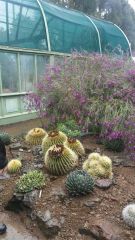
Golden barrel cactus - Cactaceae Pleated structure allows them to expand or contract based on the amount of water it holds; deep rooted |
|
|

Brachychiton populneus |

Kurrajong / bottle tree - Malvaceae Base of trunk is a water reservoir; Australian |
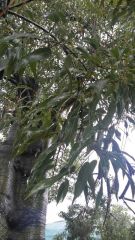
|
|
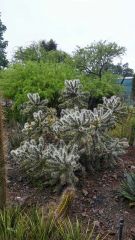
Chollas |
Opuntia spp. - Cactaceae |
|
|
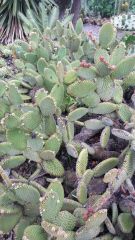
Prickly pear- Opuntia |
? |
|
|

(Ruffled) Echeveria |
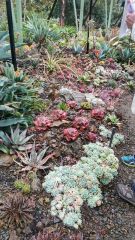
Hen and chicks - Crassulaceae New world specimens as opposed to sempervivens (which is old world) |
|
|
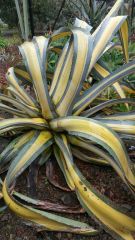
Agave americana 'Mediopicta' |
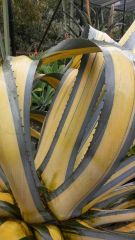
Century plant - Asparagaceae. Flowers once then dies 20-40 yrs. |
|
|
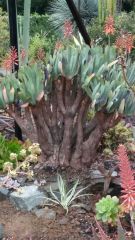
Aloe plicatilis |
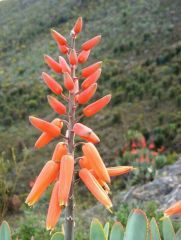
Fan aloe - Xanthorrhoeceae Two tiered foliage |
|
|

Agave attenuata |
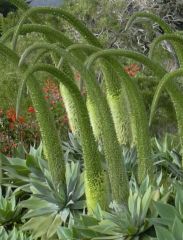
Fox tail agave |
|
|
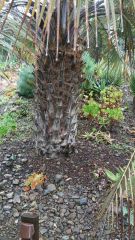
Butia capitata |
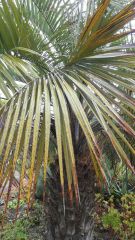
Pindo palm - Arecaceae |
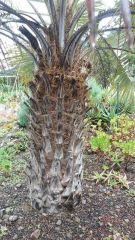
|
|

Brahea armata |
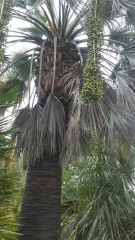
Mexican blue palm - Areacaeae 'Blue' foliage |
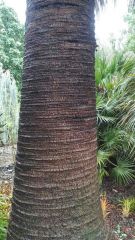
|
|
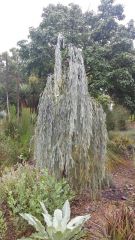
Acacia pendula |
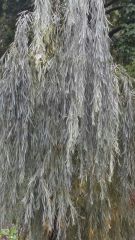
Weeping acacia - Fabaceae |
|
|
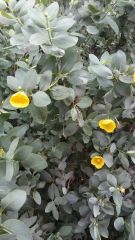
Dendromecon harfordii (dendro means tree) |
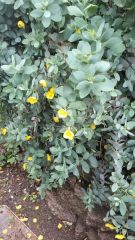
Island tree poppy - Papaveraceae Bluish foliage |

|
|
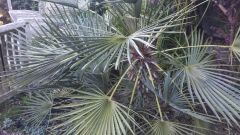
Chamaerops humilis |

Mediterranean fam palm - Arecaceae Armed with spikes along length of stem; might be confused with Mexican blue palm but it has off-shoots at base of trunk (unlike the Mexican blue) |
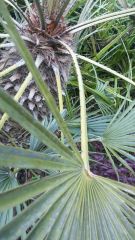
|
|
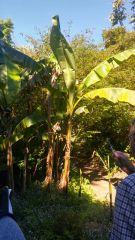
Musa basjoo |
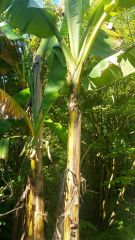
Japanese banana - Musaceae Flowers once then dies; sometimes undesirable because the large leaves catch in the wind and they tear; fruit is inedible |
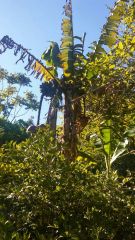
|
|
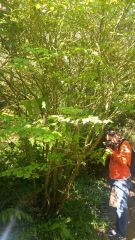
Cornus kousa |
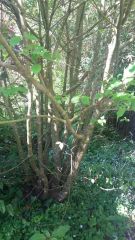
Kousa dogwood - Cornaceae Flowers start out green and then expand and turn to ivory white; opposite leaves (flowering dogwood is different b/c it flowers on naked branches |
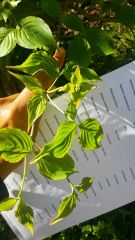
|
|

Tasmannia lanceolata |
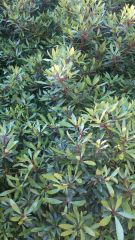
Mountain pepper - Winteraceae Evergreen; native of Tasmania; red stems; lance-shaped compacted alternate leaves that appear whirled |
|
|
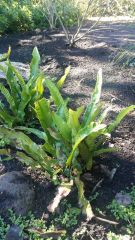
Asplenium scolopendrium |
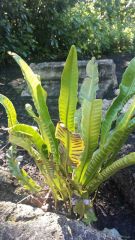
Hart's tongue fern - Aspleniaceae (reminiscent of birds nest fern); capable of growing from rock walls; fragrant, medicinal and herbal |
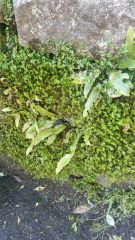
|
|
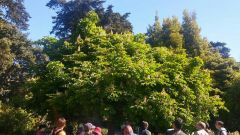
Aesculus hippocastanum |
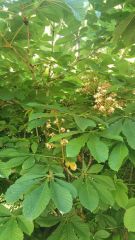
European horsechesnut Typically 7 leaflets; larger leaves than Aesculus california; deciduous; 3x taller than California buckeye; flowers have a yellow and pinkish hue; ob- ovate leaf shape |
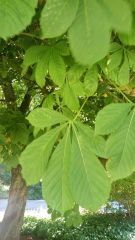
|
|
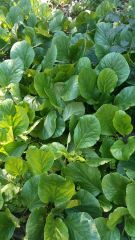
Bergenia spp & cvs |

Pig squeak- Saxifragaceae Evergreen ground cover |
|

